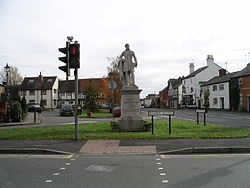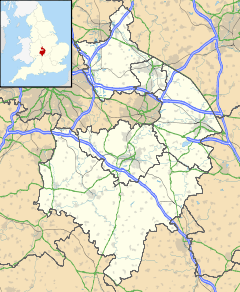- Dunchurch
-
This article is about the village in England. For the community in Ontario, Canada see Dunchurch, Ontario
Coordinates: 52°20′12″N 1°17′23″W / 52.33675°N 1.28961°W
Dunchurch
Daventry Road and the Square viewed from Rugby Road in the village centre
 Dunchurch shown within Warwickshire
Dunchurch shown within WarwickshirePopulation 2,842 OS grid reference SP485712 Parish Dunchurch District Rugby Shire county Warwickshire Region West Midlands Country England Sovereign state United Kingdom Post town RUGBY Postcode district CV23 Dialling code 01788 Police Warwickshire Fire Warwickshire Ambulance West Midlands EU Parliament West Midlands UK Parliament Kenilworth and Southam List of places: UK • England • Warwickshire Dunchurch is a civil parish and village on the south-western outskirts of Rugby in Warwickshire, England. The 2001 census recorded a population of 2,842 in the village.
Contents
History
The earliest historical reference to Dunchurch was in the Domesday Book in the 11th century which mentioned a settlement called Doncerce.
The core of the village has been declared a conservation area because it has many buildings of historical interest. Some of the buildings date from as far back as the 15th century[citation needed] are timber framed and still have traditional thatch roofs.
For centuries Dunchurch was an important staging post on the coaching roads between London and Holyhead (now the A45 road) (classified as B4429 through the village) and Oxford and Leicester (now the A426 road). At one point 40 stagecoaches plus the regular mail coach every day would stop at Dunchurch. Coaching inns developed in Dunchurch to accommodate these visitors (the "Dun Cow", the "Bell" and "the Star"). Other inns were the "Mother Red Cap", "Crown" and "Red Lion". The "Bell" and "Red Lion" premises were destroyed by a German parachute mine in 1940. All other properties can still be seen today.
Many famous people throughout history stayed at Dunchurch. Most notably in 1605, the Gunpowder Plotters stayed at the Red Lion Inn (reputed to be the private residence now called 'Guy Fawkes House') in Dunchurch awaiting news of Guy Fawkes's attempt to blow up the Houses of Parliament. If he had been successful they planned to kidnap the King's daughter Elizabeth of Bohemia from nearby Coombe Abbey.
Other famous people having stayed in the village include a young Queen Victoria (before she became Queen) and the Duke of Wellington. Robert Stephenson stayed in Dunchurch whilst supervising the construction of the Kilsby Tunnel during the building of the London and Birmingham Railway.
Dunchurch is the birthplace of the 18th century hymnwriter William Tans'ur, and in more recent times of the athlete Katharine Merry. For many years it was the home of England cricketer Ian Bell.
The coming of the railways in the 1840s led to a dramatic decline in the coaching trade, and with the development of a major junction at nearby Rugby the importance of Dunchurch rapidly declined. From 1871 until 1964 the village was served by its own railway station on the Rugby to Leamington Spa line.
Education
There are three schools in the area: Dunchurch Infant and Nursery School (School Street), Dunchurch Boughton C of E Junior School (Dew Close) and Bilton Grange Preparatory School (Rugby Road).
Religion
There are three churches in the village: St Peter's (Church of England) in the centre, a Methodist chapel in Cawston Lane and a Baptist church on the outskirts of the village on the Coventry road.
Culture
The village has a sportsfield on Rugby Road donated to the village by Baron Waring in the 1920s. Currently Dunchurch & Bilton Cricket Club play in the summer months and Dunchurch Football Club play in the winter. Cricket has been played on the land since the 1800s. In 1999 Dunchurch Cricket Club merged with Bilton Cricket Club to form Dunchurch & Bilton Cricket Club.
Other groups in the village include :- Dunchurch Silver Band, District of Dunchurch Brass, Dunchurch Festival Group, Guides, Dunchurch Health Walks, Scouts, Mothers' Union, Photographic Club, St. Peter's Bell Ringers, Dunchurch Twinning Association, Dunchurch and Thurlaston Women's Institute, Working Men's Club.
Statue
In the centre of Dunchurch is a statue of Lord John Douglas Montague Scott (1809–1860) a 19th century landlord, Scottish M.P. and younger brother of the Duke of Buccleuch. At Christmas it has been an annual tradition for more than thirty years in Dunchurch to dress up the statue in the garb of a cartoon or TV character.[1]
References
External links
- Lord of the Manor of Dunchurch
- Dunchurch Festival Group notices, etc.
- Dunchurch Parish Council
- Dunchurch Parish Council Papers
- Dunchurch Village Hall
- Dunchurch St. Peter's Church - C. of E.
- Dunchurch Baptist Church
- Dunchurch Silver Band
- District of Dunchurch Brass
- Dunchurch and Bilton Cricket Club
- Dunchurch Photographic Society
- Dunchurch 1700-1950
- Dunchurch Boughton CofE (VA) Junior School website
- Bilton Grange Preparatory School
- Photos of Dunchurch and surrounding area on geograph
Categories:- Villages in Warwickshire
Wikimedia Foundation. 2010.



